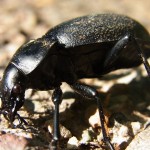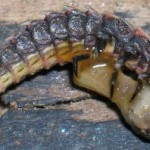Now maybe you’re in the 2016 drought zone in upstate New York. If so, slugs aren’t quite the hassle they were just a year ago. But doubtless you’ve been gardening long enough to know what a bad slug year is like. And should the weather turn drenchingly wet way longer than you need it to be, here’s what to know and what to do.
Good news first. Yes, your posies can be slug-free, mostly; you just have to plant things slugs don’t care for. Look online: you’ll find lists aplenty online with plenty of options, along with warnings about what plants to avoid. Hosta-lovers, you can even grow blue hostas — their waxy, puckered leaves are remarkably slug-resistant. Note we said “resistant.” You’ll still want to keep an eye on them.
Which goes for most posies in the plant lists, actually. Of course, there’s no point posting your lists for slugs. They’d just ignore them. If they do a number on your anemones or ignore your zinnias, chalk it up to their obstinate disregard.
Serious about your veggies? You’ve got a harder row to hoe. Onions, leeks, chives and a few herbs generally get by just fine. But from arugula to zucchini, most everything else is prey.
Slugs get out and about on damp days, but the rest of the time they do their dirty work from dusk to dawn. You could wake up to find all your baby lettuce and carrots gone. Even sturdy, well-grown plants — broccoli, say, or beans — could be shot full of holes or stripped to the bone.
Scouting is a key IPM tactic, and here’s how:
- dig holes about 4 inches across and 6 inches deep
- cover with asphalt shingles wrapped in aluminum foil. The reflective surface keeps the hole dark, cool, and moist — an ideal slug hidey-hole
- if you find more than five slugs in a hole, consider your options
Options? Slugs like to hang out with their buddies — it’s called “homing behavior.” Knowing that, one option could be as simple as placing damp boards in the aisles between rows. Tip those boards up, stomp on that little slug community (you’re wearing your gardening boots, right?) … they’re gone.
How else to cope? Acquaint yourself with your support team; that is, the critters who are on your side. (In IPM we call them biocontrols) These include slug predators like rove or ground beetles, centipedes, harvestmen (aka daddy longlegs, though granted some species are rather stout), firefly larvae (aka glow worms), soldier beetle larvae, birds, and frogs.
In fact, there’s even a critter called the “slug eater.” Hey, you can even watch one eating a slug.
(Photo credits left to right: pixabay 54479_640; Phillip-SITNAM7; Seth Ausubel.)
More biocontrols? Ducks (some people recommend Indian Runner ducks) and chickens can help too. A side benefit to chickens — as they scratch around for those tidbits of protein (aka bugs and slugs), their sharp toenails do a lovely job of tilling beds and exposing seedling weeds. But save poultry for before planting or after harvest. Meanwhile, if you’ve got a well-fenced garden and your birds have free range around the perimeter, they could intercept inward-bound pests.
Homegrown remedies are a dime a dozen. Some work, done right. (Skip the salt.) If you found this post, most likely your search also turned up plenty of others. So we’ll stick with baits based on iron phosphate. Sluggo, Slug Magic, Escar-Go!, Worry Free … these and other brands are on your garden-store shelf. They work — if you work at it.
And bear in mind — you must read the label. (The label is the law, as they say in the trade.) Slugs do the most damage when plants are young. In fact, they’re great pre-emergence seedling killers. So start your baiting early — the “early and often” approach. No way can you put bait down once and consider your problem solved. Sure, you might (if you’re lucky) kill the majority of slugs in your garden. But you have to stay on your game. Those populations will recover as time goes by.
Keep temperature and moisture in mind when you bait. Too cold and they stay underground. Ditto with too dry. (Researchers at Oregon State suggest 42 degrees as a minimum nighttime temperature for baiting). And remember this: once your plants are well grown, slugs will happily stay in the canopy — meaning they’re less likely to come down to snack on ground-level bait. Once fall rolls around and harvest is done, bait again when temperatures and mornings are damp — helps cut down on egg-laying slugs; bait again, even later, to get the newly-hatched babes.
And now? Out to the garden to scout for slugs.


